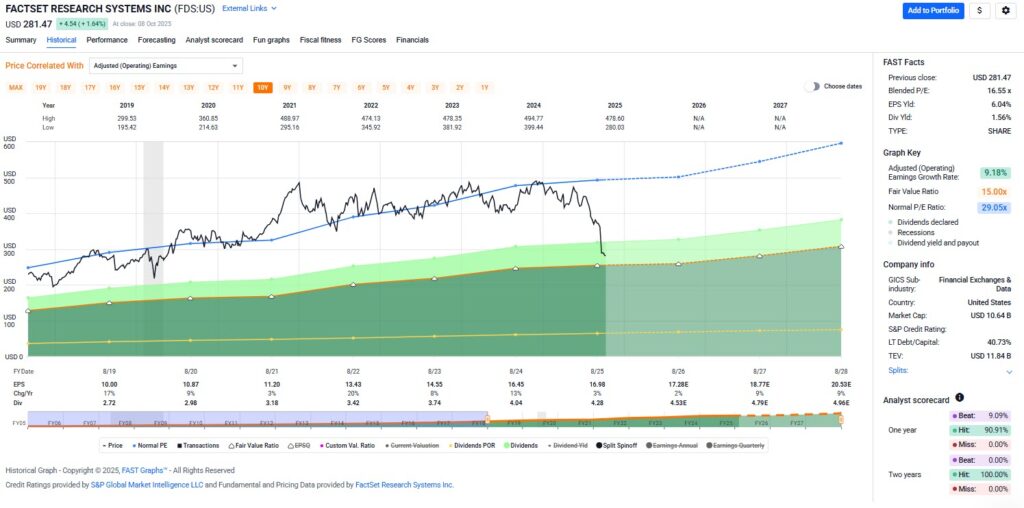FactSet: Evaluating The Recent Decline-Time To Buy Or Stay Away?
Image Source: Unsplash
Time to Buy or Stay Away
In this video, Chuck Carnevale, co-founder of FAST Graphs and known as Mr. Valuation, takes a deep look at FactSet Research Systems (FDS) — time to buy? The company that provides data to FAST Graphs itself. FactSet has always been known as a high-quality, consistent business, but Chuck uses it to illustrate an important investing truth:
Valuation matters, and it matters a lot.
Why FactSet?
FactSet has been a favorite among investors for years because of its strong business model, recurring revenue, and reliable growth. But the market has almost always priced it at a premium — often 25 to 30 times earnings, which is far above what most would consider fair value.
Chuck points out that such a high multiple means investors have historically been willing to pay 25 years of earnings in advance, leaving them with a very low earnings yield, usually below 4%. That’s a steep price for even the best company.
(Click on image to enlarge)

The Recent 40% Drop
For the first time in decades, FactSet’s stock fell sharply — over 40% from 2024 to 2025.
Chuck explains what caused this rare correction:
- A small earnings miss in the third quarter of 2025
- Margins fell from around 37% to 33%
- Higher compensation costs and weaker guidance
- A CEO transition, which made investors uneasy
Even though revenue still grew nearly 6% year-over-year, the market reacted strongly. Chuck believes this drop had more to do with valuation and sentiment than with any serious business weakness.
A Consistent, Profitable Business
FactSet remains a strong, steady company:
- Earnings have grown year after year
- Dividends have increased consistently since 2009
- Payout ratio: 25–30% of earnings — healthy and sustainable
- Free cash flow easily covers the dividend
- Margins are still solid, and debt is modest
Chuck emphasizes that the fundamentals look fine. FactSet’s business is stable, its products are essential to clients, and it generates predictable cash flow. The problem wasn’t the company — it was how much investors were paying for it.
What FAST Graphs Reveals
Using FAST Graphs, Chuck shows how the orange line (earnings) and the black line (price) relate over time.
Whenever the black line moves far above the orange line, the stock is overvalued. When it moves below, it’s undervalued.
FactSet has almost always traded well above its fair-value line — except for a brief period during the 2008–2009 recession. Chuck says that would have been the only time he’d have bought it. He doesn’t believe in overpaying for great companies, no matter how consistent they are.
Growth and Valuation Scenarios
Chuck explores different potential outcomes:
- Over the past 10–15 years, earnings grew 9–10% annually.
- Analysts now expect 6–9% growth over the next few years.
- If FactSet traded at a fair P/E of 15×, investors might earn 5–6% annually.
- If it returns to its typical premium (25–30×), returns could reach 25–30% per year — potentially doubling your money in three years.
That’s the power — and the risk — of valuation swings. A company’s quality can stay the same, but when sentiment changes, prices can move dramatically.
Why the Market Loves FactSet
Chuck admits he’s never fully understood why the market has rewarded FactSet with such a high multiple for so long.
It’s not growing faster than peers like Ameriprise or Ecolab, which trade at much lower valuations.
But the market often places a premium on stability and reliability — similar to how investors have long paid up for Coca-Cola or Procter & Gamble, even with slower growth.
Still, Chuck reminds viewers that quality doesn’t justify any price. Buying even the best business at too high a valuation can lead to poor long-term returns.
Final Thoughts
FactSet is still an outstanding company — profitable, dependable, and well-managed. Is it a company that it’s time to buy?
The recent selloff has brought the stock closer to a reasonable valuation, though Chuck still sees it as fully valued by intrinsic standards.
If the market eventually restores its traditional premium multiple, returns could be excellent. If not, investors can still expect modest but steady growth and dividends.
Either way, the key takeaway is timeless:
“Valuation matters, and it matters a lot.”
Video Length: 00:24:07
More By This Author:
Comcast Stock Analysis: Is The Risk Worth The Reward?Want Stock Market Success? Forecast Earnings Like Mr. Valuation
Dissecting The S&P 500 – Should You Invest?
Disclosure: No position.
Disclaimer: The opinions in this article are for informational and educational purposes only and should not be construed as a recommendation to buy or sell the stocks ...
more



